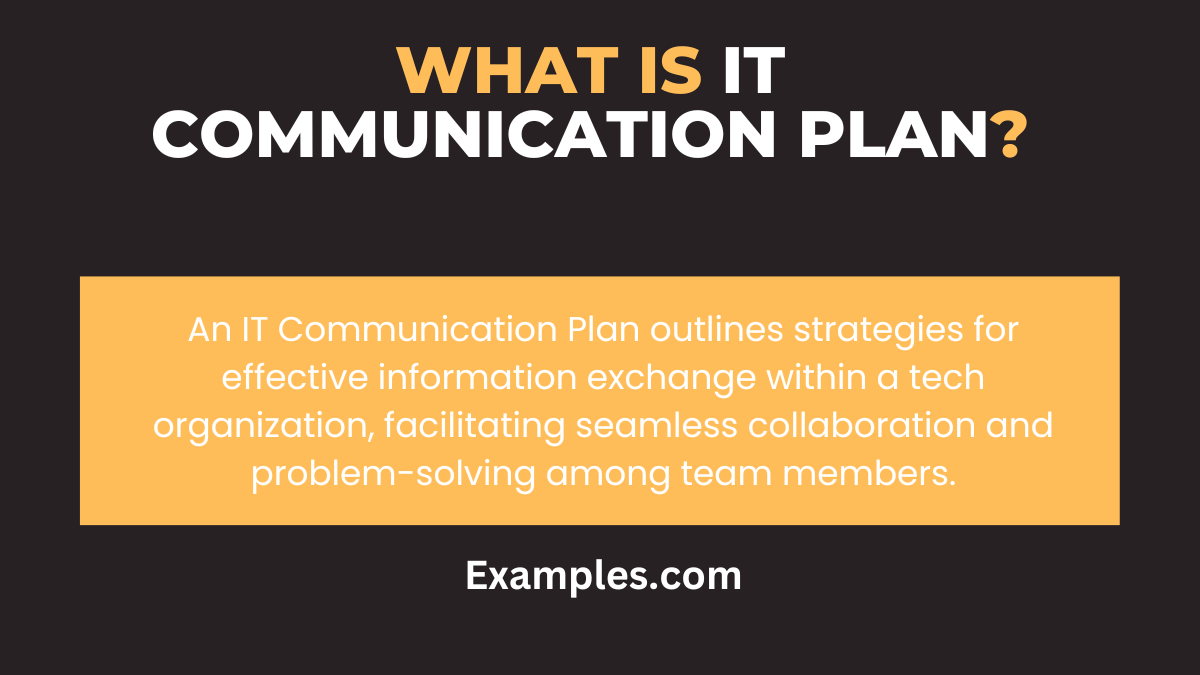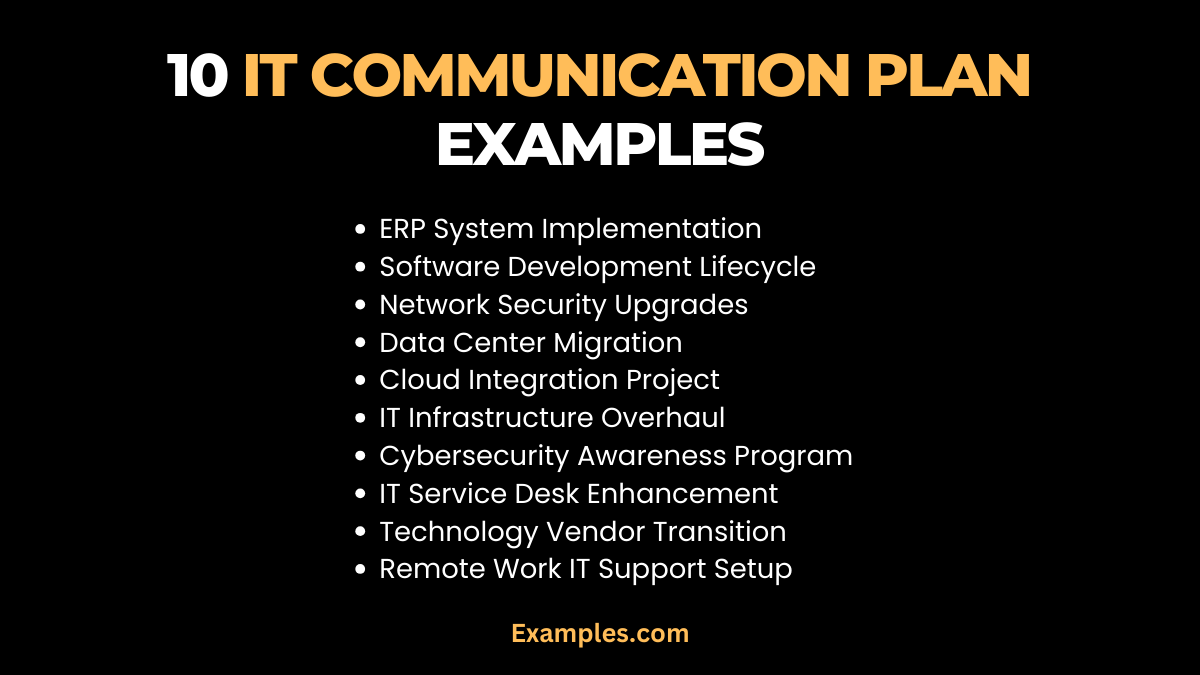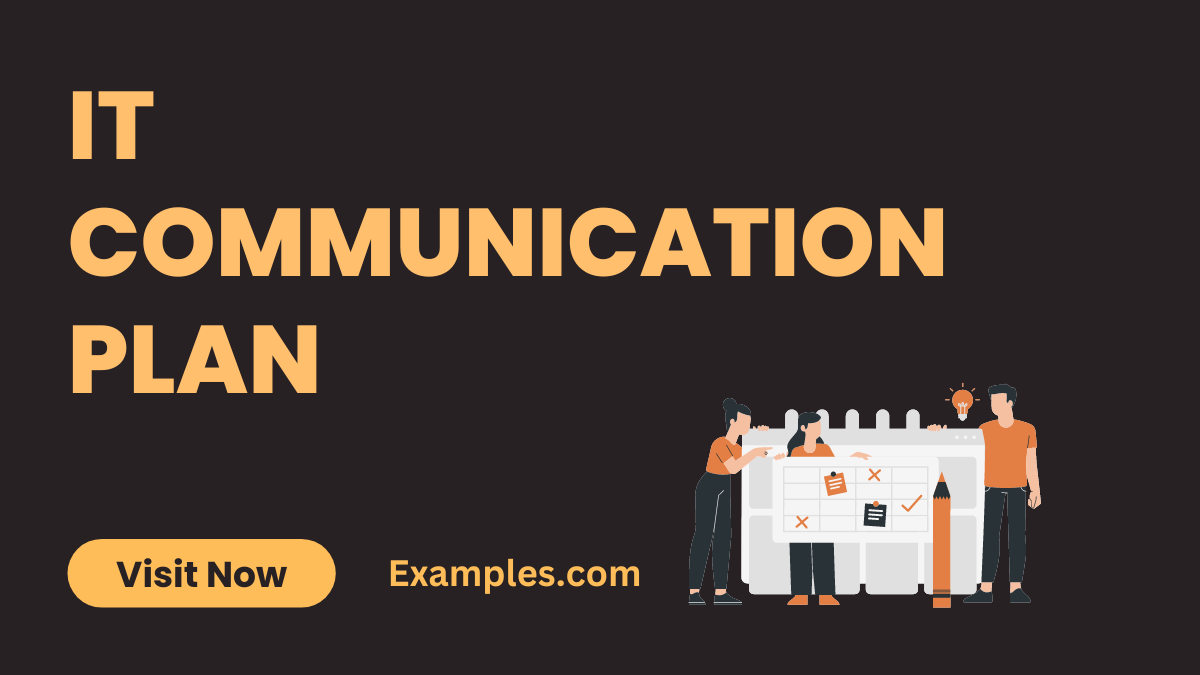9+ IT Communication Plan Examples
In today’s fast-paced digital world, effective communication is the cornerstone of IT success. This comprehensive guide delves into the nuances of IT Communication Plans, offering invaluable insights and real-world communication examples. We’ll explore strategies and methods that enhance interaction within tech teams and stakeholders. Whether you’re a seasoned IT professional or new to the field, this guide provides practical examples and tips to optimize your communication processes, ensuring clarity and efficiency in every tech endeavor.
Download Improving Visual Communication Skills PDF
What is IT Communication Plan? – Meaning

An IT Communication Plan is a strategic roadmap designed specifically for managing and optimizing the flow of information within information technology projects or departments. It outlines how to effectively share updates, progress, and critical data among team members, stakeholders, and sometimes customers. The plan details the methods, tools, and schedules for communication, ensuring that all involved parties receive timely and relevant information. This is crucial for the smooth operation and success of IT initiatives, as it keeps everyone informed, aligned, and engaged with the ongoing processes and developments.
What is the best Example of IT Communication Plan?

One of the best examples of an IT Communication Plan is found in large-scale IT projects, such as the implementation of a new enterprise software system within an organization. This plan begins with a clear objective: to ensure all stakeholders are informed and engaged throughout the project’s lifecycle. It includes a detailed breakdown of communication channels like email updates, regular meetings, and project dashboards.
The plan typically outlines who will communicate (project managers, IT staff), what will be communicated (progress updates, milestone achievements, potential issues), and how often communication will occur (weekly, bi-weekly, or as needed). It also incorporates feedback mechanisms, allowing team members to provide input and ask questions.
In this example, the IT Communication Plan plays a pivotal role in managing expectations, mitigating risks, and fostering a collaborative environment. It ensures that all parties, from executives to end-users, are aligned with the project’s goals, timeline, and outcomes. Such a plan is instrumental in navigating the complexities of IT projects, leading to more successful and efficient implementations.
10 IT Communication Plan Examples

Effective IT communication is vital for project success. This list of 10 distinct IT Communication Plan examples highlights various scenarios, underlying causes, and remedies, offering valuable insights for IT professionals. Each example underscores the importance of strategic communication in IT environments, providing practical solutions for common communication challenges.
- ERP System Implementation:
- Cause: Lack of clarity in roles.
- Fix: Define clear roles and responsibilities, and regular status updates.
- Software Development Lifecycle:
- Cause: Misalignment between developers and stakeholders.
- Fix: Regular sprint reviews and stakeholder meetings.
- Network Security Upgrades:
- Cause: Inadequate updates on security protocols.
- Fix: Frequent briefings and updated documentation.
- Data Center Migration:
- Cause: Insufficient real-time incident communication.
- Fix: Implement an incident management system with immediate alerts.
- Cloud Integration Project:
- Cause: Confusion over cloud solutions.
- Fix: Educative sessions and clear documentation.
- IT Infrastructure Overhaul:
- Cause: Overlooked end-user communication.
- Fix: User-focused newsletters and feedback channels.
- Cybersecurity Awareness Program:
- Cause: Low employee engagement.
- Fix: Interactive training and regular updates.
- IT Service Desk Enhancement:
- Cause: Poor communication of service changes.
- Fix: Regular IT support updates and Q&A forums.
- Technology Vendor Transition:
- Cause: Misunderstandings due to vendor change.
- Fix: Detailed briefings and transition plans.
- Remote Work IT Support Setup:
- Cause: Inadequate support for remote employees.
- Fix: Dedicated channels for remote IT support and frequent check-ins
IT Project Communication Plan
An IT Project Communication Plan is essential for the seamless execution of tech projects. It ensures all stakeholders are informed and engaged throughout the project lifecycle. A well-crafted plan enhances team collaboration, mitigates risks, and aligns goals.
- Agile Software Development: Facilitates rapid response to changes.
- Communication Example: “Team, let’s review our sprint progress and adapt our strategy for the next sprint.”
- Cross-Functional Tech Initiative: Promotes interdisciplinary understanding.
- Communication Example: “Let’s align our department goals in this week’s interdepartmental meeting.”
- Tech Product Launch: Coordinates marketing and development teams.
- Communication Example: “Marketing and development teams will have joint sessions to sync on launch strategies.”
IT Department Communication Plan
The IT Department Communication Plan focuses on internal communication within the IT team, promoting transparency and efficiency. It’s pivotal for quick problem-solving and fostering a collaborative work environment.
- Technology Upgrade Announcement: Keeps the team informed about new tools and technologies.
Example: “We are upgrading our database system next month, let’s prepare for the transition.” - Regular IT Team Meetings: Ensures continuous team alignment and updates.
Example: “In our weekly meeting, we’ll discuss ongoing issues and brainstorm solutions.” - IT Policy Changes: Updates the team on revised policies and procedures.
Example: “Please review the updated IT security policies and provide your feedback.”
IT Incident Communication Plan
An IT Incident Communication Plan is critical for managing and responding to IT crises. It outlines the protocols for reporting incidents and coordinating responses to minimize impact.
- System Outage Response: Quick and clear communication during system outages.
Example: “We are experiencing a system outage; the team is working on a resolution.” - Data Breach Notification: Addresses the communication strategy post a data breach.
Example: “A breach has been detected; please follow the outlined security protocols immediately.” - Emergency Tech Support: Provides immediate assistance during critical technical issues.
Example: “Emergency support is available 24/7 for any urgent technical issues.”
IT Communication Plan Examples in Business
IT Communication Plan Examples in Business highlight how technology communication strategies are implemented in the corporate world, facilitating better decision-making and project management.
- Enterprise Resource Planning (ERP) Implementation: Streamlines communication during ERP integration.
Example: “All departments will receive weekly updates on the ERP implementation progress.” - Customer Relationship Management (CRM) System Training: Enhances understanding and usage of the CRM system.
Example: “Join the training session to learn about the new features in our CRM system.” - Technology Partnership Announcement: Communicates new tech partnerships to all relevant parties.
Example: “We are excited to announce our new partnership with [Tech Company], bringing innovative solutions.
Why an IT Communication Strategy and Plan Are Important?
In the realm of information technology, an IT Communication Plan is not just beneficial; it’s a necessity. This strategy is vital for several reasons:
- Enhances Clarity and Direction: A well-defined communication plan offers clear guidance on how information should be disseminated within an IT project or department. This clarity prevents misunderstandings and ensures that everyone is working towards the same objectives.
- Improves Stakeholder Engagement: Keeping stakeholders informed and involved is crucial. An effective communication plan ensures that stakeholders are aware of project progress, changes, and decisions, fostering a sense of involvement and trust.
- Facilitates Efficient Problem-Solving: In IT, issues can escalate quickly. A robust communication strategy allows for rapid dissemination of information, enabling teams to address problems effectively and efficiently.
- Supports Change Management: IT environments are often dynamic and subject to frequent changes. A communication plan helps manage these changes smoothly by preparing and guiding team members through transitions.
- Boosts Team Morale and Productivity: When communication is clear and consistent, it reduces frustration and confusion among team members, leading to higher morale and productivity.
How to Write an Effective IT Communication Plan?
Creating an effective IT Communication Plan requires a structured approach.
- Define Your Objectives: Start by outlining what you aim to achieve with your communication plan. Objectives should be specific, measurable, achievable, relevant, and time-bound (SMART).
- Identify Your Audience: Understand who your stakeholders are. This includes team members, management, clients, or any other parties involved. Tailor your communication methods to suit their needs and preferences.
- Choose Your Communication Tools and Channels: Decide on the tools (like emails, project management software, etc.) and channels (meetings, reports, dashboards) that will be used for communication. The choice should align with the nature of the information and the audience’s preferences.
- Develop a Communication Schedule: Establish a timeline for regular updates and reports. This schedule should balance the need for timely information with the risk of information overload.
- Plan for Crisis Communication: Include protocols for urgent or unexpected situations. This might involve setting up a rapid response team or using specific channels for crisis communication.
- Implement Feedback Mechanisms: Ensure there are avenues for receiving feedback. This could be through surveys, suggestion boxes, or regular meetings.
- Review and Adapt: Regularly review the effectiveness of your communication plan. Be prepared to make adjustments as the project progresses or as circumstances change.
What Should an IT Communications Plan Include?
An IT communications plan should include clear objectives, target audience identification, selected communication channels, a detailed schedule, feedback mechanisms, and crisis communication strategies.
What is an IT Communication Technology Plan?
An IT communication technology plan outlines the tools and platforms used for communication in IT projects, focusing on technology-driven methods to streamline information sharing and collaboration.
Creating an effective IT Communication Plan is crucial for the success of any technology-related project. By following the steps outlined in this article, you can ensure that your IT team, stakeholders, and end-users are well-informed and engaged throughout the project’s lifecycle. Remember that clear communication, regular updates, and feedback mechanisms are the cornerstones of a successful plan.
To further enhance your understanding of IT communication planning, we recommend exploring additional resources from authoritative sources. You can find expert insights and best practices in IT communication planning . These high-quality resources offer valuable information to help you refine your IT communication strategies and ensure the success of your technology initiatives.



